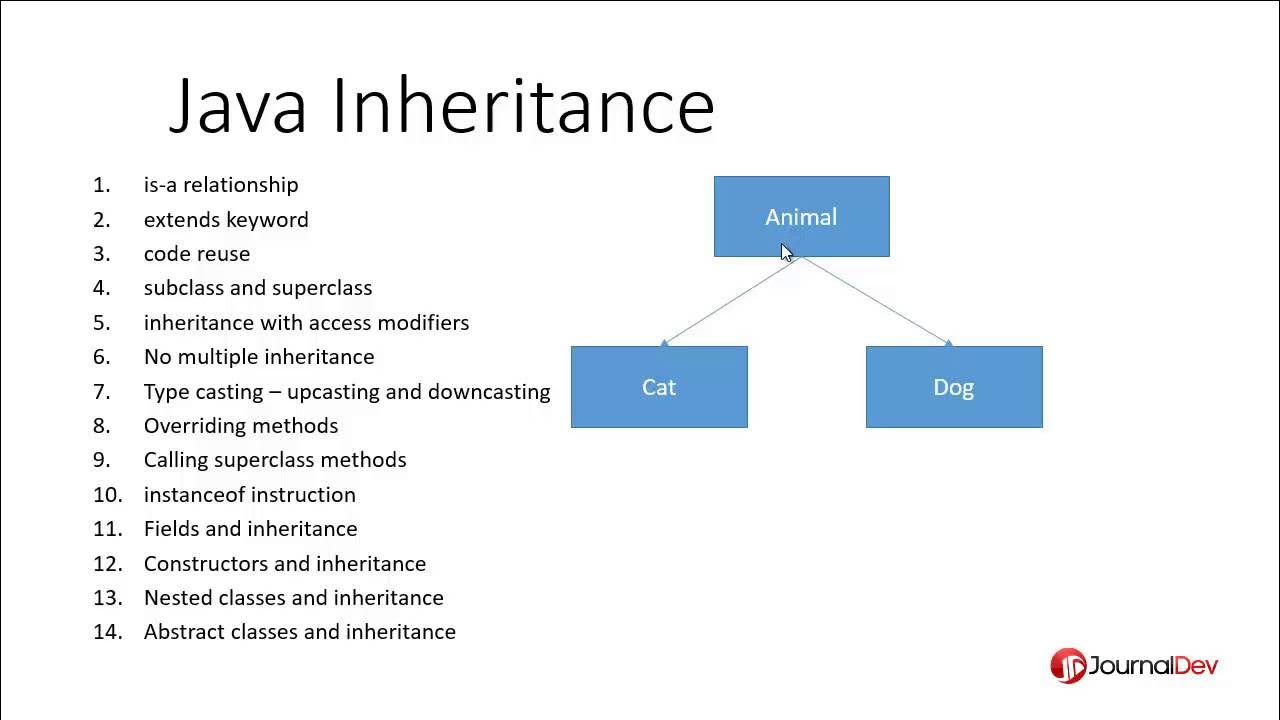Praktikum 2 PBO - Java Inheritance
Summary
TLDRThis instructional session explains key object-oriented programming concepts in Java, focusing on inheritance and aggregation. It covers how a subclass inherits properties and methods from a superclass, with examples of single, multilevel, and hierarchical inheritance. The session also discusses method overriding, where subclasses redefine inherited methods for specific behavior. Aggregation, a 'has-a' relationship between classes, is contrasted with inheritance's 'is-a' relationship. The importance of avoiding multiple inheritance in Java to reduce ambiguity is highlighted, providing a comprehensive understanding of Java's inheritance mechanisms and best practices.
Takeaways
- 😀 Inheritance in Java is a mechanism where a subclass inherits properties and methods from a parent class.
- 😀 The 'extends' keyword is used in Java to indicate that a class is inheriting from another class.
- 😀 A subclass can access all properties and methods of its parent class, but not vice versa.
- 😀 Inheritance enhances code reusability, allowing subclasses to inherit common features from parent classes without re-declaring them.
- 😀 In Java, multiple inheritance (inheriting from more than one class) is not supported to avoid ambiguity in method execution.
- 😀 Java supports single inheritance, where a class inherits from one parent class, and multilevel inheritance, where a chain of inheritance occurs across multiple levels.
- 😀 Hierarchical inheritance involves a single parent class being inherited by multiple subclasses.
- 😀 Aggregation in Java refers to a class containing objects of another class as its members, which is different from inheritance.
- 😀 The relationship in aggregation is 'has a', while in inheritance it is 'is a'. For example, a `Mahasiswa` 'is a' `Person`, but a `Pegawai` 'has a' `Alamat`.
- 😀 Method overriding in Java occurs when a subclass defines a method with the same signature as its parent class, allowing it to provide its own implementation.
- 😀 Polymorphism is achieved when a subclass method overrides a parent class method, changing its behavior, as seen in the `Kucing` class overriding the `makan` method.
Q & A
What is inheritance in Java?
-Inheritance in Java is a mechanism where one class acquires all the properties and behaviors (methods) of another class. The class that inherits is called the subclass, and the class being inherited from is called the superclass.
What is the purpose of using inheritance in Java?
-The main purposes of using inheritance are to achieve code reusability and polymorphism. A subclass can inherit methods and properties from the superclass, allowing for code reuse and easier maintenance.
What is the role of the 'extends' keyword in inheritance?
-The 'extends' keyword in Java is used to define inheritance. It allows a class to inherit properties and methods from another class, enabling a subclass to reuse the code of its superclass.
Can you explain polymorphism in the context of inheritance?
-Polymorphism allows an object to take many forms. In the context of inheritance, polymorphism enables a subclass to override methods from the superclass, so the same method name can behave differently depending on the subclass implementation.
What is the difference between inheritance and aggregation in Java?
-Inheritance represents an 'is-a' relationship, where a subclass is a type of the superclass. Aggregation represents a 'has-a' relationship, where a class contains objects of other classes. For example, a 'Person' class may have an 'Address' object, but 'Person' is not an 'Address'.
What types of inheritance are supported in Java?
-Java supports several types of inheritance: single inheritance, multilevel inheritance, and hierarchical inheritance. However, multiple inheritance, where a class inherits from multiple classes, is not supported in Java.
Why does Java not support multiple inheritance?
-Java does not support multiple inheritance to avoid complexity and ambiguity. If a class inherits from multiple classes with the same method name, it could cause conflicts about which method to call, leading to unpredictable behavior.
What is the difference between a superclass and a subclass?
-A superclass is a class that provides properties and methods that can be inherited by another class. A subclass is a class that inherits from the superclass and can also add its own properties and methods.
How does method overriding work in Java?
-Method overriding occurs when a subclass provides its own implementation of a method that is already defined in the superclass. This allows the subclass to alter or extend the behavior of the method as needed.
What is the significance of the 'super' keyword in inheritance?
-The 'super' keyword in Java is used to refer to the superclass. It can be used to call a method from the superclass or to access a superclass's constructor from a subclass.
Outlines

Cette section est réservée aux utilisateurs payants. Améliorez votre compte pour accéder à cette section.
Améliorer maintenantMindmap

Cette section est réservée aux utilisateurs payants. Améliorez votre compte pour accéder à cette section.
Améliorer maintenantKeywords

Cette section est réservée aux utilisateurs payants. Améliorez votre compte pour accéder à cette section.
Améliorer maintenantHighlights

Cette section est réservée aux utilisateurs payants. Améliorez votre compte pour accéder à cette section.
Améliorer maintenantTranscripts

Cette section est réservée aux utilisateurs payants. Améliorez votre compte pour accéder à cette section.
Améliorer maintenantVoir Plus de Vidéos Connexes

Inheritance in Java - Java Inheritance Tutorial - Part 2

OOPS CONCEPTS - JAVA PROGRAMMING

Kotlin For Beginners - Variance, Covariance, Contravariance and Type erasure

Inheritance in Java - Java Inheritance Tutorial - Part 1

PBO 2 - JAVA - Liskov Substitution

What Is Java? | Java In 5 Minutes | Java Programming | Java Tutorial For Beginners | Simplilearn
5.0 / 5 (0 votes)
